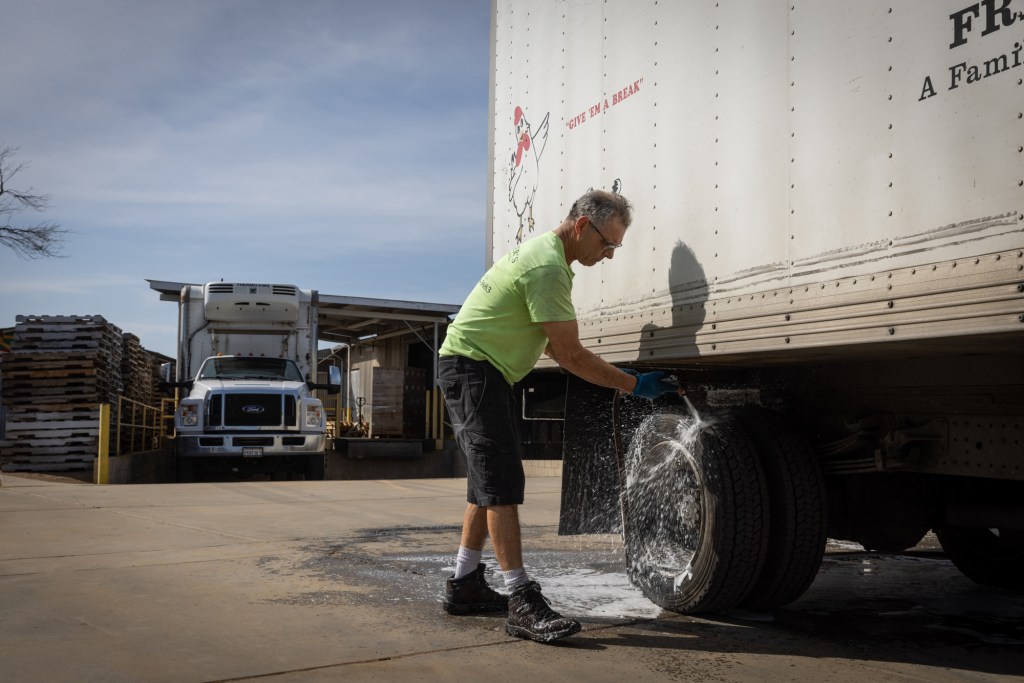
Three years into a nationwide avian influenza outbreak that has forced millions of egg-laying birds to be killed after becoming infected, Hilliker’s Ranch in Lakeside has been able to keep producing day in and day out with a little luck and a lot of effort around sanitation.
While it has not had to take the hazardous materials-style precautions employed by larger ranches, especially those situated near other large operations in agricultural areas such as California’s Central Valley, Hilliker has nonetheless had to tighten its procedures with an eye toward protecting the nearly 30,000 leghorn chickens in its free-range barns.
That means this family-run business, which delivers fresh eggs throughout San Diego County, from Oceanside all the way to San Ysidro, now requires its employees to wash the undercarriage of delivery trucks with special antiviral soap when they return from running their routes. And workers must step in a foot wash bath when coming to work, killing anything that may be riding on the bottoms of soles when shifts begin. There is also a deeper focus on making sure that workers who are sick stay home. Tours of the operation for interested members of the public, many who visit regularly to buy eggs from the ranch’s storefront, have been off the docket for some time.
All of these measures, notes Frank Hilliker, whose family started the egg ranch in 1942, have worked to prevent the truly awful eventuality that many producers have experienced as the virus tears through flocks. The USDA says 101 commercial flocks and 55 in backyards —collectively representing 21.68 million birds — have been affected nationwide in the past 30 days. So much infection has not only caused psychic pain for the workers who must do this grim work, but also for those paying more for eggs.
The price for California-compliant eggs, those that meet the state’s requirement for cage-free production, has increased rapidly, hitting $9.32 per dozen in the U.S. Department of Agriculture’s latest weekly report Friday. That’s nearly double the $4.41 per dozen jumbo eggs listed in the same report one year ago and more than three times higher than the $2.65 listed in 2022.
Hilliker’s is far from the only egg ranch operating in San Diego County. Though no comprehensive census is published by the local farm bureau, the state’s list of registered egg handlers includes dozens of local producers, mostly small operations, with the densest concentration in Ramona.

To be an egg rancher these past three years, even one with thousands rather than millions of birds to manage, is a job prone to endless worry about a threat that, in addition to possibly arriving attached to machinery or footwear, is also a possibility with every passing wild bird.
Situated as San Diego County is in the great Pacific Flyway, the strip of land over which migratory flocks fly every year, makes it important that every stray dropping that may fall on the grounds be sprayed down as quickly as possible.
It is enough to drive endless worry. But, eventually, a guy just can’t keep staying up at night worrying about what might happen.
“If I worry about it, I’ll be anxious,” Hilliker said. “I won’t be able to sleep, and I just have to accept the fact that we could get it, it could happen.
“Of course, I don’t want it to happen, but I can’t sit around and wring my hands about it … life is too short … when my dad was around, I just learned that, hey, there are just things you can’t control.”
But there is more control in other countries. A big step could be taken to help the Hillikers and their fellow egg ranchers nationwide sleep a little more easily.
A 2023 synopsis produced by the University of Nebraska notes that China, Mexico and Egypt vaccinate poultry against avian influenza and have had significant success in reducing bird mortality. And 27 European Union countries began testing vaccines that same year, with field studies showing effectiveness. A systematic review of poultry vaccination against avian influenza published by a team of researchers at National Taiwan University in Taipei concluded that they have an efficacy of “78% to 97%.”
Merced County-based poultry veterinarian Nancy Reimers who travels frequently to consult with producers trying to protect their flocks, said that while there has been an increasing call for flu vaccination of American animals for many years, vaccination has been more than a passing idea in the United States.
“We have some products that have been licensed in the U.S. and have been studied in the past and, in previous occasions, we’ve had a stockpile that the federal government has maintained; it’s just not a vaccine that we’re allowed to use,” Reimers said.
The government’s own statement backs her up. In a news release issued on Jan. 8, the U.S. Department of Agriculture notes that it “created a national vaccine stockpile for use in commercial poultry, though the vaccines at that time were never deployed.”
Why make it but never use it?
As the USDA’s recent news release acknowledges, vaccinating chickens “may have trade implications.”
Export regulations generally forbid flu vaccination of livestock, including cows and chickens.
“For a long time, using the influenza vaccine in your birds was basically a non-tariff trade barrier,” Reimers said. “It’s still the way, as I understand it, that most of our trade treaties are written, stating that we will not vaccinate birds.”
But the current situation, one in which widespread cullings have driven up the price of eggs, may force the issue.
Now, a new effort is underway to rebuild the stockpile with a new vaccine built to match the currently circulating strain of H5N1 influenza that has forced the killing of more than 150 million chickens nationwide.

Just last week, Zoetis, a New Jersey-based biopharmaceutical company that specializes in animal medications and vaccines, announced that it received a conditional license from the Department of Agriculture to produce an avian influenza vaccine for use in chickens.
As the company’s statement makes clear, a license is not enough to spur a wave of poultry vaccination. Taking that step, according to Zoetis, “rests solely with national regulatory authorities in consultation with their local poultry sector.”
The industry, Reimers added, has tried for three years now to end the current H5N1 outbreak through “biosecurity” initiatives like those used by Hilliker Egg Ranch. In places where multiple large egg ranches are operating relatively close to each other, she said, it is not uncommon to tell workers that they can’t work at multiple livestock locations or keep chickens at home. And there has been news coverage of some very large organizations requiring their employees to shower before entering their facilities and also after their shifts are finished and it is time to go home.
Trade barriers seem more likely to be broken as biosecurity measures fail to extinguish what has been three years of spread.
“Our current tools have not been adequate to stop this virus,” Reimers said. “The rules are designed for low path(ogenic) influenza that’s seasonal, that just comes in with the migrating waterfowl, but that’s not what we have currently.
“I think there’s going to be a strong effort from egg producers to get this vaccine approved. At some point, you have to match the tools to the problem at hand.”
For his part, Hilliker said that he will follow Reimers’ lead in deciding whether or not to vaccinate his flock if the vaccine is ultimately approved for use by the USDA. He said the birds already receive a handful of vaccines against other threats such as salmonella and Newcastle disease.
“I’m just listening to Dr. Nancy on this one,” he said.
Originally Published:







